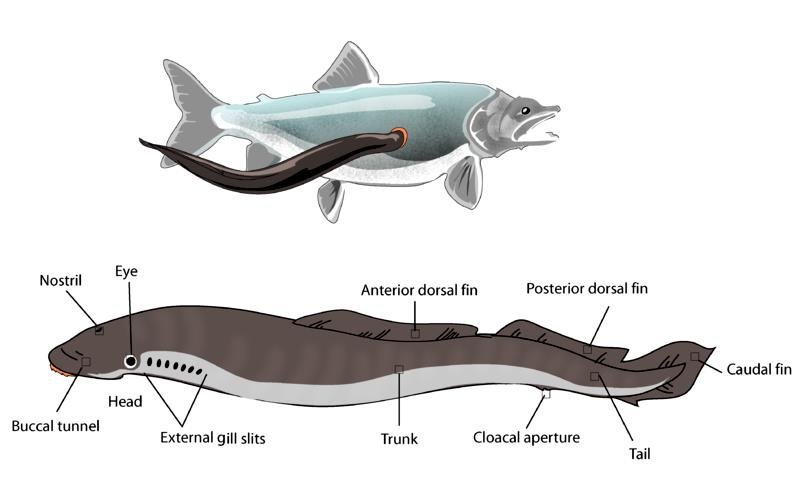Table of Contents
Digestive System of Petromyzon:
Buccal Cavity and Mouth:
Petromyzon has a complete digestive system with the alimentary canal starting at the mouth and ending at the anus, the mouth present on the ventral side of the anterior part of the cylindrical head. Petromyzon feed on other fishes, their mouth show adaptation for parasitism. The ventral side of the head has a cup-shaped depression, the cup-shaped depression is actually the buccal cavity or buccal funnel. The circular muscle present in the cup-shaped buccal cavity is responsible for making the buccal cavity sucking nature and helps to attach with the body of host fishes.
The buccal cavity has several denticules, some of them are bicuspid, the sucking buccal cavity, and the denticles help in attachment to the host fish. At the center of the buccal cavity, a small circular mouth opening is present, the tongue is present in the mouth opening, the piston-like movement of the tongue can open and close the opening of the mouth.
The buccal cavity is a common chamber for ingestion of food and respiration, the buccal cavity is connected to two tubes, one is the esophagus which is part of the digestive system while another tube in the respiratory tract.

The ventral tube connected to the buccal cavity is closed at another end, the tube has seven pairs of gill slits on each side of the head. As the buccal cavity is connected to the esophagus as well as the respiratory canal so there is a high chance of entering the food into the respiratory canal, but the food from the buccal cavity does not enter the respiratory tract due to the presence of velum. Velum is a valve-like structure that prevents food from entering the respiratory canal from the buccal cavity.
Esophagus:
The mouth opening leads to a straight tube-like esophagus, there is no stomach in the digestive system of Petromyzon. The esophagus opens directly into the intestine, the posterior dilated part of the esophagus function as the stomach when the esophagus opens into the intestine there is a valve. The intestine has a special spiral longitudinal fold known as spiral valve or typhlosole, the intestine finally opens outside through the anus, the anus opens into the cloaca.
Digestive Glands:
The digestive system of Petromyzon has different digestive glands, at the mouth, the buccal cavity has opened of the salivary gland. Petromyzon tears the tissues of host fishes and sucks the blood, but there are chances of coagulation of the blood, the coagulation is prevented by the anticoagulant present in the saliva secreted by the salivary gland.

The anterior part of the intestine has a bilobed liver, a gall bladder, and a bile duct is associated with the liver. The gall bladder and the bile sac are only present in Ammocoet larva but in the adult stage, the liver is not associated with the gall bladder and bile duct.
The pancreas and spleen are not present but the zymogen cells are present on the epithelium of the intestine are responsible for the secretion of pancreatic enzymes. The cells of follicles of Langerhans present on the intestinal epithelial are endocrine in nature and responsible for controlling blood glucose levels.
Feeding Mechanism of Petromyzon:
Petromyzon lives in the aquatic environment and the adult Petromyzon becomes parasitic on the larger fishes. The sucking buccal cavity helps them to attach with the victim fishes, the tongue present in the buccal cavity takes the bite of the victim tissue and ingests it.

Lamprey sucks the blood and body fluids from the victim fish from the place of a puncture, the anticoagulant present in the saliva does not allow the blood and body fluids to clot. In this way, Petromyzon does not enter into the victim’s body but sucks the body fluids from outside but the wound makes by then became sometimes fatal for the fish, especially when the Petromyzon make the wound at the abdominal region of the victim fishes.
Detailed Study On
Anatomy of Petromyzon (Lamprey)
External Morphology of Petromyzon
Habit and Habitat of Petromyzon(Lamprey)
Classification of Class Ostracodermi
Phylogeny of Subphylum Vertebrata
An Overview of Classification in Subphylum Vertebrata
Subphylum Vertebrata and its Diversity
Cephalochordata Characteristics Features Classification Examples and Diagram
Urochordata Classification Morphology Characteristic Features
Characteristics Features of Hemichordata
General Comparison of Hemichordata Urochordata and Cephalochordata
Comparative Study of Digestive System in Hemichordata Cephaochordata and Urochordata
Hi Everyone!!! Welcome to Imaluop. Imaluop always try to learn some new and he want to share to other people. Here we will try to learn various topics on Science, specially on Biological Sciences.